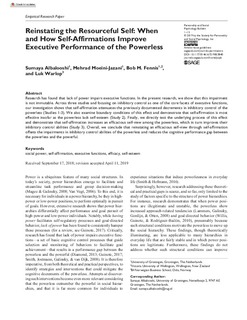| dc.contributor.author | AlBalooshi, Sumaya | |
| dc.contributor.author | Moeini-Jazani, Mehrad | |
| dc.contributor.author | Fennis, Bob M. | |
| dc.contributor.author | Warlop, Luk | |
| dc.date.accessioned | 2019-06-21T13:18:59Z | |
| dc.date.available | 2019-06-21T13:18:59Z | |
| dc.date.created | 2019-06-12T10:20:13Z | |
| dc.date.issued | 2019 | |
| dc.identifier.citation | Personality and Social Psychology Bulletin 2019 | nb_NO |
| dc.identifier.issn | 0146-1672 | |
| dc.identifier.uri | http://hdl.handle.net/11250/2601724 | |
| dc.description.abstract | Research has found that lack of power impairs executive functions. In the present research, we show that this impairment is not immutable. Across three studies and focusing on inhibitory control as one of the core facets of executive functions, our investigation shows that self-affirmation attenuates the previously documented decrements in inhibitory control of the powerless (Studies 1-3). We also examine boundary conditions of this effect and demonstrate that self-affirmation is most effective insofar as the powerless lack self-esteem (Study 2). Finally, we directly test the underlying process of this effect and demonstrate that self-affirmation increases an efficacious self-view among the powerless, which in turn improves their inhibitory control abilities (Study 3). Overall, we conclude that reinstating an efficacious self-view through self-affirmation offsets the impairments in inhibitory control abilities of the powerless and reduces the cognitive performance gap between the powerless and the powerful. | nb_NO |
| dc.description.abstract | Reinstating the Resourceful Self: When and How Self-Affirmations Improve Executive Performance of the Powerless | nb_NO |
| dc.language.iso | eng | nb_NO |
| dc.publisher | Sage | nb_NO |
| dc.relation.uri | https://journals.sagepub.com/doi/10.1177/0146167219853840 | |
| dc.rights | Navngivelse-Ikkekommersiell 4.0 Internasjonal | * |
| dc.rights.uri | http://creativecommons.org/licenses/by-nc/4.0/deed.no | * |
| dc.title | Reinstating the Resourceful Self: When and How Self-Affirmations Improve Executive Performance of the Powerless | nb_NO |
| dc.type | Journal article | nb_NO |
| dc.type | Peer reviewed | nb_NO |
| dc.description.version | publishedVersion | nb_NO |
| dc.source.journal | Personality and Social Psychology Bulletin | nb_NO |
| dc.identifier.doi | https://doi.org/10.1177/0146167219853840 | |
| dc.identifier.cristin | 1704229 | |
| cristin.unitcode | 158,11,0,0 | |
| cristin.unitname | Institutt for markedsføring | |
| cristin.ispublished | true | |
| cristin.fulltext | original | |
| cristin.qualitycode | 2 | |

